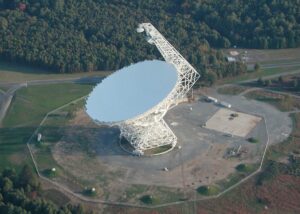Aug
28
SETI and the Drake Equation
“I am usually baffled by the thoughts and accomplishments of humans in different cultures. I’ll be damned if I can state with certainty what some extraterrestrial source of intelligence might do.” — Stephen Jay Gould, noted paleontologist and evolutionary biologist

When I wrote “SETI and the Fermi Paradox”, it was all I could do to keep from delving into the Drake Equation, because they are inextricably linked. Frank Drake, of course, wasn’t the first to attempt a formula like this. In fact, the brilliant Dr. Fermi was known for doing complex calculations in his head, and Herbert York recalled that when Fermi posed his question to his lunch-mates, he made several such rapid calculations before concluding that Earth should have been visited many times by now. Though these calculations were never published, it is quite possible that Fermi speculated on several of the factors in what is now known as the Drake Equation.
Why does Drake get the honor? In 1960, Drake was a radio astronomer working at the National Radio Astronomy Observatory (NRAO) in Green Bank, West Virginia. Following the suggestion by physicists Giuseppe Cocconi and Philip Morrison that alien transmission might be found at a wavelength of 21 cm (1,420.4 MHz), Drake made the first systematic SETI survey (dubbed Project Ozma), focusing on the nearby stars Epsilon Eridani and Tau Ceti. The following year, while organizing the first ever conference on the search for extraterrestrial intelligence, which was meeting there in Green Bank, Drake formulated the equation as a means of stimulating conversation among the attendees. And that it did.
(Btw, Drake has been involved with SETI research for over six decades now and sits on the SETI Institute’s board of trustees.)
The celebrated equation is: N = R(*) x f(p) x n(e) x f(l) x f(i) x f(c) x L
where
N = the number of civilizations in the Milky Way Galaxy with which communication might be possible;
and
R(*) = the average annual rate of star formation in our Galaxy
f(p) = the fraction of *those* stars that have planets
n(e) = the average number of those planets that are environmentally suitable for life
f(l) = the fraction of those planets that could support life that actually develop life at some point
f(i) = the fraction of those planets with life that actually go on to develop intelligent life (civilizations)
f(c) = the fraction of those civilizations that develop a technology that releases detectable signs of their existence into space (presumably via electromagnetic emissions)
L = the length of time (in Earth years) for which such civilizations release detectable signals into space
In his book (which I got the other day), theoretical physicist Stephen Webb notes that Fermi would have been guided by the Principle of Mediocrity, which posits that there is nothing special about Earth or our Solar System. Given this, Webb thinks that if Fermi had had Drake’s Equation in mind in 1950, he might reasonably (if optimistically) have used the following values:
R(*) = 1; f(p) = 0.5 (i.e., half of the stars have planets); n(e) = 2; f(l) = 1; f(i) = 1; f(c) = 0.1; L = 1,000,000
This gives a value of 100,000 for N (though Webb mistakenly says 1,000,000).
When that 1961 meeting in Green Bank occurred, “the only factor which we had any basis to estimate with reasonable accuracy was the first, the rate of stellar formation.” The ten or so attendees (which included Carl Sagan) decided on the following values:
R(*) = 1; f(p) = 0.2 to 0.5; n(e) = 1 to 5; f(l) = 1; f(i) = 1; f(c) = 0.1 to 0.2; L = 1000 to 100,000,000
Thus, N might conservatively be only 20 or quite optimistically as much as 50,000,000. But, Drake states that given the uncertainties, the original meeting concluded that N’s range is roughly the same as that of L. Other estimates using different values have given end results ranging from multiple millions (of communicative civilizations) to numbers so small as to be considered zero (i.e., suggesting that we are probably alone in this galaxy, and possibly in the observable universe.)

As per Wikipedia, one is likely to see current estimates (or speculations) for the Drake parameters like: R(*) = 1.5 to 3; f(p) = ~1; n(e) = ~0.4; f(l) = no valid estimates can be made (given current sample size of 1, i.e., Earth); f(i) = ranging from very tiny to 1; f(c) = very hard to say; L = ranging from a few hundred to billions of years
It should be obvious that, for the equation to be at all helpful, it relies on accurate, or at least reasonable, data. The last three parameters are still wholly speculative, whereas the three before them are — despite a growing number of exoplanets and their stars catalogued — still subject to varying degrees of conjecture. As astrophysicist Jeff Zweerink has stated,
“To determine all these factors will require research in disciplines including astronomy, physics, planetary science, geology, biology, biochemistry, and many others. In fact, scientists have formed a discipline called astrobiology that encompasses the specific aspects of all these other disciplines that pertain to life’s existence. A major component of astrobiological research entails the search for other planets that might host life.” (Is There Life Out There? (2017))
There has been plenty of criticism aimed at the Drake Equation over the years — mostly due to the speculative nature of most of the parameters, resulting in big error bars and no firm conclusions. But, then, it was always meant to be primarily a way to stimulate dialogue on the relevant topics, hopefully sparking ideas for how to gather more (and more relevant) data. Some critiques have led to proposals for modifications, including the need to account for such things as biogenic gases, colonization, civilization appearing more than once on a world (aka “reappearance factor”), the fraction of communicative civilizations that actually engage in deliberate interstellar transmission (aka the “METI factor”), et al.
I think this is great, but I am concerned about some other assumptions being made by many (most?) doing SETI research. I mentioned earlier that Fermi et al. were likely guided by the Principle of Mediocrity regarding Earth and our Solar System. That principle is itself an extension of the Copernican (or Cosmological) Principle, a rather uncontroversial, philosophical statement that “Earth occupies no special location in the universe — not the center, not near the edge, nor any other geometrically interesting point.” However, as proponents of the Rare Earth hypothesis point out (and I have blogged on before), evidence continues to mount about Earth and our Solar System that make our home a truly “privileged planet”.

The mediocrity principle is often extended to humanity as well, asserting that we are “not special in any way and that human origin and development have likely been duplicated on billions of other sites throughout the cosmos.” A 2020 paper proposed an “Astrobiological Copernican” principle, speculating further that “intelligent life would form on other [Earth-like] planets like it has on Earth, so within a few billion years life would automatically form as a natural part of evolution”. This makes f(l) and f(i) both equal 1, i.e., a certainty.
They talk about planets being suitable for life if located in “habitable” zones. But most understand this only to mean that they are in orbit around their star in such a way that allows for liquid water. Even if that was the only state of water needed, it ignores many more factors necessary for life, especially complex life, such as being in galactic zones with suitably low radiation, high star metallicity, and low enough density to avoid excessive asteroid bombardment; also, having large gas giants which provide bombardment protection without a hot Jupiter, a planet with plate tectonics, a large moon that creates tidal pools, and moderate axial tilt to generate seasonal variation. Even if all these parameters were found in a planetary system other than ours, life is not inevitable, and certainly not billions of years ago, even if one assumes naturalistic processes can do the job. Likelihood of intelligent life is even smaller. (Evolutionary biologist Ernst Mayr, for example, recognized this and estimated f(i) to be around 1 in a billion.)
Incidentally, Webb says that the life-scientists (as opposed to physical scientists and non-scientists) that he knows “don’t buy the deterministic ‘high intelligence evolved on Earth so it must eventually evolve on other planets’ argument. They tend to see the implausibility, rather than the inevitability, of intelligence.” (pp. 334-5) And he agrees with them. This is quite interesting, because it is my understanding that those in the life sciences are usually less apt to admit the limitations of naturalistic processes.
The anthropic principle posits that while humanity’s place in the universe is not spatially central (a la the Copernican Principle), “it does not necessarily follow that humanity’s place is not central, or special, in any way.” However, as astrophysicist Hugh Ross has stated,
“What makes humanity’s location in the cosmos unique, or special, is that Earth resides away from the center of any astronomical system, such as Earth’s galaxy. Humanity lives in a unique location — and moment — in cosmic space-time that allows not only for the possibility of human existence but also for the opportunity to discover that human existence represents a miracle, a special case.”

As for the Drake Equation, some (e.g., astrophysicist Paul Sutter) believe that it has outlived its usefulness, if it ever had any at all. They make some fair points. Despite my own criticisms and skepticism (or perhaps because of it), though, I tend to agree with the position that
“…the usefulness of the Drake equation is not in the solving, but rather in the contemplation of all the various concepts which scientists must incorporate when considering the question of life elsewhere, and gives the question of life elsewhere a basis for scientific analysis. The equation has helped draw attention to some particular scientific problems related to life in the universe, for example abiogenesis, the development of multi-cellular life, and the development of intelligence itself.” (Wikipedia)
I’m no scientist, but think that a modified Drake Equation is the way to go. Will it ever produce a definitive value (or even a helpful, narrow range of values) for ‘N’? Probably not. But, I think that it still serves as a good way to summarize the problem while breaking it up into bite-size pieces for study. My hope is that, as additional parameters are factored in over time, more scientists will recognize the true complexity and rarity of life — let alone complex, intelligent life — in the universe, as well as the amazing fine-tuning of multiple factors for humankind on Earth. This can’t help but point to the existence of the sovereign, Creator/Designer God of the Bible.















